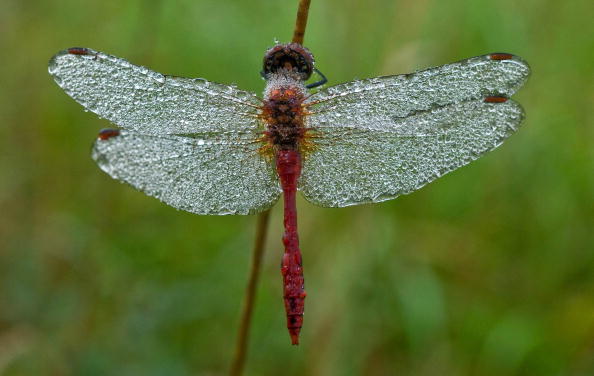Scientists have uncovered the physics-defying secret of insect wings


Not even the best pilot in the world can fly an airplane like the erratic path of an insect, and now scientists know why — bugs are simply exempt from the same laws of aerodynamics that apply to airplanes.
"We've known for quite a while that the aerodynamic theory for airplanes doesn't work so well in predicting the force of lift for flapping wings. We found that the drag or wind resistance also behaves very differently, and we put together a new law that could help explain how insects move through the air," assistant professor at New York University's Courant Institute of Mathematical Sciences, Leif Ristroph, told Futurity.
Researchers had to go back to the drawing board to figure out the significance of wing thrust on overcoming aerodynamic drag. While an airplane, with its static wings, must increase its thrust fourfold to double its flight speed against wind resistance, a bug only needs to double its thrust to go twice as fast due to having a drag "that is in direct proportion to its flight speed," Ristroph said.
The Week
Escape your echo chamber. Get the facts behind the news, plus analysis from multiple perspectives.

Sign up for The Week's Free Newsletters
From our morning news briefing to a weekly Good News Newsletter, get the best of The Week delivered directly to your inbox.
From our morning news briefing to a weekly Good News Newsletter, get the best of The Week delivered directly to your inbox.
To understand this, though, the NYU researchers actually built robotic wings to measure the way the air flowed and where the forces were acting. And now that they know more about how the drag on the wing acted more like a thrust in some instances, they think they may be able to design "tiny flying robots that mimic the wing motions of insects," Futurity reports.
Hey, at least robotic bugs don't sting. If you want to learn more — and are undaunted by the title "Linear drag law for high-Reynolds-number flow past an oscillating body" — check out the full study with diagrams in Physical Review Fluids, here.
A free daily email with the biggest news stories of the day – and the best features from TheWeek.com
Jeva Lange was the executive editor at TheWeek.com. She formerly served as The Week's deputy editor and culture critic. She is also a contributor to Screen Slate, and her writing has appeared in The New York Daily News, The Awl, Vice, and Gothamist, among other publications. Jeva lives in New York City. Follow her on Twitter.
-
 ‘Let 2026 be a year of reckoning’
‘Let 2026 be a year of reckoning’Instant Opinion Opinion, comment and editorials of the day
-
 Why is Iran facing its biggest protests in years?
Why is Iran facing its biggest protests in years?TODAY’S BIG QUESTION Iranians are taking to the streets as a growing movement of civic unrest threatens a fragile stability
-
 How prediction markets have spread to politics
How prediction markets have spread to politicsThe explainer Everything’s a gamble
-
 Israel approves new West Bank settlements
Israel approves new West Bank settlementsSpeed Read The ‘Israeli onslaught has all but vanquished a free Palestinian existence in the West Bank’
-
 US offers Ukraine NATO-like security pact, with caveats
US offers Ukraine NATO-like security pact, with caveatsSpeed Read The Trump administration has offered Ukraine security guarantees similar to those it would receive from NATO
-
 Hong Kong court convicts democracy advocate Lai
Hong Kong court convicts democracy advocate LaiSpeed Read Former Hong Kong media mogul Jimmy Lai was convicted in a landmark national security trial
-
 Australia weighs new gun laws after antisemitic attack
Australia weighs new gun laws after antisemitic attackSpeed Read A father and son opened fire on Jewish families at Sydney’s Bondi Beach, killing at least 15
-
 How Bulgaria’s government fell amid mass protests
How Bulgaria’s government fell amid mass protestsThe Explainer The country’s prime minister resigned as part of the fallout
-
 Benin thwarts coup attempt
Benin thwarts coup attemptSpeed Read President Patrice Talon condemned an attempted coup that was foiled by the West African country’s army
-
 Femicide: Italy’s newest crime
Femicide: Italy’s newest crimeThe Explainer Landmark law to criminalise murder of a woman as an ‘act of hatred’ or ‘subjugation’ but critics say Italy is still deeply patriarchal
-
 Brazil’s Bolsonaro behind bars after appeals run out
Brazil’s Bolsonaro behind bars after appeals run outSpeed Read He will serve 27 years in prison
